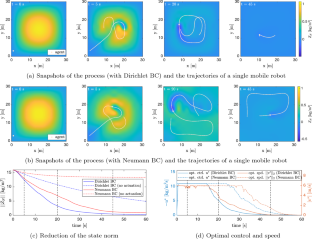Cooperative estimation and control of a diffusion-based spatiotemporal process using mobile sensors and actuators
Abstract
Monitoring and controlling a large-scale spatiotemporal process can be costly and dangerous for human operators, which can delegate the task to mobile robots for improved efficiency at a lower cost. The complex evolution of the spatiotemporal process and limited onboard resources of the robots motivate a holistic design of the robots’ actions to complete the tasks efficiently. This paper describes a cooperative framework for estimating and controlling a spatiotemporal process using a team of mobile robots that have limited onboard resources. We model the spatiotemporal process as a 2D diffusion equation that can characterize the intrinsic dynamics of the process with a partial differential equation (PDE). Measurement and actuation of the diffusion process are performed by mobile robots carrying sensors and actuators. The core of the framework is a nonlinear optimization problem, that simultaneously seeks the actuation and guidance of the robots to control the spatiotemporal process subject to the PDE dynamics. The limited onboard resources are formulated as inequality constraints on the actuation and speed of the robots. Extensive numerical studies analyze and evaluate the proposed framework using nondimensionalization and compare the optimal strategy to baseline strategies. The framework is demonstrated on an outdoor multi-quadrotor testbed using hardware-in-the-loop simulations.


 求助内容:
求助内容: 应助结果提醒方式:
应助结果提醒方式:


